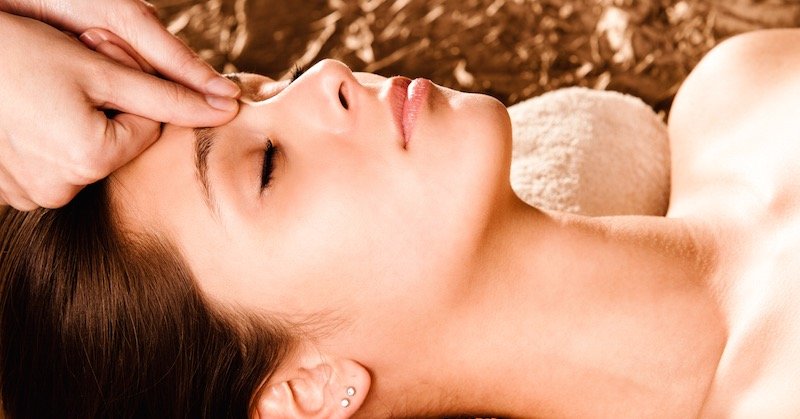Headaches that originate at the base of the skull can be particularly uncomfortable and concerning. You may feel a throbbing or piercing pain that radiates from the base of the skull. It may also extend to the scalp, temples, or behind the eyes. While they are often caused by tension or poor posture, they can also be a sign of more serious conditions. This article will discuss common causes of Headaches at the base of the skull with treatment.
Understanding the Anatomy
The base of the skull, also known as the occipital region, is where the skull connects with the cervical spine (neck). This area contains several important nerves, muscles, and blood vessels that can contribute to headaches when irritated or compressed.
The occipital nerves, which run from the top of the spinal cord to the scalp, are particularly susceptible to inflammation or injury. This can lead to a condition called occipital neuralgia.
Common Causes of Headache at the Base of the Skull
1. Tension Headaches
Tension headaches are the most common type of headache and often cause pain at the base of the skull. They are usually triggered by stress, poor posture, eyestrain, or jaw clenching. Symptoms include:
- Tightness or pressure around the head, neck, and shoulders
- Mild to moderate pain that may be severe at times
- Pain that is not worsened by physical activity
Tension headaches can often be managed with over-the-counter pain relievers, relaxation techniques, and lifestyle changes such as improving posture and managing stress.
2. Cervicogenic Headaches
Cervicogenic headaches originate from disorders of the neck and can cause pain at the base of the skull that may extend to the front of the head or between the shoulder blades. They are often caused by neck injuries, poor posture, or cervical disc problems. Symptoms include:
- Steady, non-throbbing pain at the back and base of the skull
- Pain that may extend to the forehead, temples, or between the shoulder blades
- Stiff neck and reduced range of motion
- Nausea, dizziness, or blurred vision
Treatment for cervicogenic headaches may include physical therapy, medications such as muscle relaxants or anti-inflammatory drugs, and in some cases, nerve block injections or surgery.
3. Occipital Neuralgia
Occipital neuralgia is a condition in which the occipital nerves become inflamed or injured. This can cause intense, sharp, or electric-shock-like pain at the base of the skull and back of the head. Other symptoms may include:
- Aching, burning, or throbbing pain
- Pain on one or both sides of the head
- Sensitivity to light
- Tender scalp
Treatment options for occipital neuralgia may include medications such as anti-inflammatory drugs, muscle relaxants, or antidepressants, as well as nerve block injections, physical therapy, and in rare cases, surgery.
4. Migraine Headaches
Migraine headaches can cause severe, throbbing pain that may affect the back of the head. They are often accompanied by other symptoms such as nausea, vomiting, and sensitivity to light and sound. Some people may experience an aura before the onset of a migraine, which can include visual disturbances or tingling sensations.
Treatment for migraines may include over-the-counter or prescription pain relievers, preventive medications such as beta-blockers or antidepressants, and lifestyle changes such as stress management and avoiding triggers.
5. Cluster Headaches
Cluster headaches are a rare but extremely painful type of headache that can cause pain at the base of the skull, often behind one eye. They occur in cyclical patterns or clusters and are more common in men. Symptoms include:
- Severe, burning, or piercing pain behind or around one eye
- Pain that may radiate to the forehead, temple, nose, cheek, or upper gum on the affected side
- Restlessness or agitation during an attack
- Watery eye, nasal congestion, or runny nose on the affected side
Treatment for cluster headaches may include oxygen therapy, triptan medications, or preventive medications such as verapamil or lithium.
6. Temporomandibular Joint (TMJ) Disorders
TMJ disorders, which affect the jaw joint and muscles, can cause pain at the base of the skull. This can happen as well as in the face, jaw, and ears. They are often caused by jaw clenching, teeth grinding, or arthritis. Symptoms include:
- Pain or tenderness in the jaw, face, neck, or shoulders
- Clicking, popping, or grating sounds in the jaw joint when opening or closing the mouth
- Difficulty or discomfort while chewing
- Locking of the jaw joint, making it difficult to open or close the mouth
Treatment for TMJ disorders may include jaw exercises, pain relievers, muscle relaxants, or wearing a mouthguard to prevent teeth grinding.
7. Arthritis of the Neck
Arthritis of the neck, also known as cervical spondylosis, can cause pain at the base of the skull due to the wear and tear of the vertebrae and discs in the neck. It is more common in older adults and can be aggravated by poor posture or neck injuries. Symptoms include:
- Pain and stiffness in the neck that may radiate to the base of the skull, shoulders, or arms
- Headaches, particularly at the back of the head
- Grinding or popping noise when turning the neck
- Muscle weakness or numbness in the arms or hands
Treatment for arthritis of the neck may include physical therapy, pain relievers, anti-inflammatory medications, or in severe cases, surgery.
Less Common Causes
In rare cases, headaches at the base of the skull may be a sign of more serious conditions, such as:
- Brain tumors
- Aneurysms
- Meningitis
- Head or neck injuries
- Arnold-Chiari malformation, a congenital defect where brain tissue extends into the spinal canal
- Paget’s disease of the bone, which can cause the skull to thicken and put pressure on the brain
If you experience a sudden, severe headache accompanied by symptoms such as fever, stiff neck, confusion, or vision changes, seek immediate medical attention.

How to Get Rid of Headache at the Base of the Skull
1. Stretch and Massage the Neck and Head
One of the most effective ways to alleviate a headache at the base of the skull is to gently stretch and massage the neck and head. This can help relax tight muscles that may be causing a tension headache. Here’s how to do it:
- Gently tilt your head to the left, bringing your left ear towards your left shoulder. Hold for 15-30 seconds, then repeat on the right side.
- Slowly rotate your head in a half-circle from shoulder to shoulder, keeping your chin level. Repeat 5-10 times.
- Use your fingertips to gently massage the base of your skull, neck, and shoulders. Focus on any areas that feel particularly tense or sore.
Remember to be gentle and stop if you experience any pain or discomfort.
2. Apply Heat to the Base of the Skull
Applying heat to the base of the skull can help soothe sore muscles and increase blood flow to the area, which may help relieve a headache. Here’s how to do it:
- Use a hot pack, heating pad, or warm compress. You can also take a warm shower or bath.
- Place the heat source on the back of your neck and the base of your skull for 10-20 minutes at a time.
- Repeat as needed throughout the day.
If you prefer, you can alternate between heat and cold therapy. Some people find that applying an ice pack to the base of the skull for 10-15 minutes, followed by heat for 10-15 minutes, provides relief.
3. Improve Your Posture
Poor posture, especially when sitting at a desk or using electronic devices for extended periods, can strain the neck and lead to headaches. Here are some tips for improving your posture:
- Sit up straight with your shoulders back and your ears aligned with your shoulders.
- Keep your feet flat on the floor and your knees at a 90-degree angle.
- Adjust your chair height and computer screen so that your eyes are level with the top of the screen.
- Take frequent breaks to stand up, stretch, and move around. Aim for at least a 5-minute break every hour.
When using your phone or tablet, hold the device at eye level instead of looking down at it. This can help prevent neck strain and headaches.
4. Manage Stress
Stress and anxiety can cause muscle tension in the neck and shoulders, leading to headaches. Here are some strategies for managing stress:
- Practice relaxation techniques like deep breathing, meditation, or yoga. There are many free apps and online resources that can guide you through these practices.
- Make time for hobbies and activities you enjoy, such as reading, gardening, or spending time with friends and family.
- Exercise regularly. Physical activity can help reduce stress and tension. Aim for at least 30 minutes of moderate exercise most days of the week.
- Consider talking to a therapist or counselor if stress is a significant problem in your life.
5. Try Over-the-Counter Pain Relievers
If self-care measures aren’t providing relief, over-the-counter pain medications may help alleviate the pain of a tension headache. Here are some options:
- Acetaminophen (Tylenol)
- Ibuprofen (Advil, Motrin)
- Naproxen (Aleve)
Follow the dosage instructions carefully and do not take more than the recommended amount. If you find yourself relying on pain relievers frequently, talk to your doctor about other treatment options.
6. Consider Complementary Therapies
In addition to the strategies mentioned above, some people find relief from headaches at the base of the skull through complementary therapies. Here are a few options to consider:
- Acupuncture: This traditional Chinese medicine technique involves inserting thin needles into specific points on the body to alleviate pain and promote healing.
- Massage therapy: A skilled massage therapist can help relax tense muscles in the neck and shoulders, which may help relieve headaches.
- Chiropractic care: A chiropractor can perform spinal manipulations and other techniques to alleviate tension and improve alignment in the neck and spine.
- Biofeedback: This technique involves learning to control certain bodily functions, like muscle tension, to reduce pain and stress.
Before trying any complementary therapy, talk to your doctor to make sure it’s safe and appropriate for you.
7. Maintain a Healthy Lifestyle
In addition to the specific strategies for getting rid of headaches at the base of the skull, maintaining a healthy lifestyle can help prevent headaches from occurring in the first place. Here are some tips:
- Stay hydrated by drinking plenty of water throughout the day.
- Eat a balanced diet that includes plenty of fruits, vegetables, whole grains, and lean protein.
- Get enough sleep each night. Aim for 7-9 hours of quality sleep.
- Limit alcohol and caffeine intake, as these can contribute to dehydration and disrupt sleep.
- Don’t smoke. Smoking can worsen headaches and increase the risk of other health problems.
When to See a Doctor?
While most headaches at the base of the skull are not serious, it’s important to see a doctor if:
- Your headache is severe, sudden, or accompanied by unusual symptoms such as fever, stiff neck, confusion, or vision changes
- You experience frequent or worsening headaches that interfere with your daily activities or quality of life
- Your headache does not respond to over-the-counter medications or self-care measures
- You have a history of head or neck injuries, or you suspect an underlying medical condition may be causing your headaches
- You experience jaw pain, clicking, or locking that does not improve with self-care measures
Conclusion
Headaches at the base of the skull can be caused by a variety of factors, from tension and poor posture to more serious underlying conditions. By trying a combination of self-care measures, lifestyle changes, and medical treatment when needed, most people can find relief from these headaches.
Remember to listen to your body and see a doctor if you experience severe, frequent, or worsening headaches, or if your headaches are accompanied by other symptoms. With the right approach and care, it is possible to get rid of headaches at the base of the skull and improve your overall quality of life.






